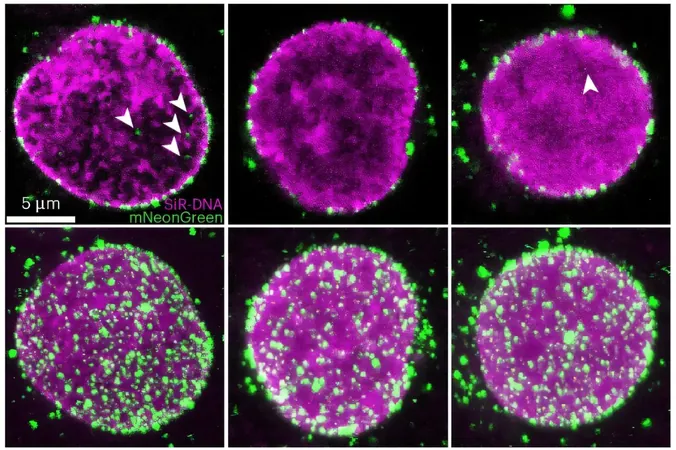
Unlocking the Secrets of HIV: Scientists Capture Viral Cores infiltrating Cell Nucleus Like Never Before!
2025-07-21
Author: Arjun
Revolutionary Breakthrough in HIV Research!
In a groundbreaking study, researchers have unveiled the intricate process by which HIV-1 breaches the cell's nuclear defenses, a revelation that could transform antiviral therapies forever. Under the leadership of Professor Peijun Zhang from the University of Oxford, this remarkable research harnessed cutting-edge cryo-electron microscopy to observe HIV-1 viral cores as they embark on their perilous journey into the nucleus—a previously elusive stage of the virus's life cycle.
A Close-Up Look at Viral Entry!
Published in the prestigious journal Nature Microbiology, this study utilized the advanced facilities at the UK National Electron Bio-Imaging Centre (eBIC). The team adeptly employed a technique known as cell-permeabilization, which allows researchers to create tiny openings in the cell membrane without causing damage. This innovative approach enabled them to recreate the infection process, leading to the capture of nearly 1,500 viral cores infiltrating a cell's nucleus.
A Game-Changer: How HIV-1 Breaches the Nuclear Barrier!
The findings shed light on crucial factors that dictate HIV-1's success in breaching the nucleus. The research highlights the significance of the viral cores' shape and flexibility, the adaptability of the nuclear pore complex (NPC), and critical host factors such as CPSF6. This host protein is pivotal during the initial stages of HIV-1 infection and plays an essential role in ensuring the virus gains access to the nucleus to integrate with the host's genetic material.
Rethinking the Role of the Nuclear Pore!
Traditionally, the nuclear pore was viewed as a rigid gateway with limited entry access. However, this study reveals a much more dynamic picture; the nuclear pore can expand and alter its shape to facilitate the passage of HIV viral cores—making it an active participant in the viral entry process.
Not All Cores Make It: A New Understanding of Viral Access!
Interestingly, not every viral core successfully enters the nucleus. If the core is too fragile or fails to interact with CPSF6, it becomes stuck at the pore or is left behind, indicating that the nuclear pore is discerning about which viruses are permitted entry. This insight dramatically reshapes our comprehension of HIV infection and its interaction with human cells.
The Ongoing Struggle Against HIV-1!
Since the first reported case in 1981, Human Immunodeficiency Virus Type 1 (HIV-1) has posed a relentless challenge to public health, leading to over 42 million deaths and more than 1 million new infections annually. This research not only deepens our understanding of HIV-1 but also showcases the power of in situ structural biology in unraveling complex cellular processes.
A Leap Towards Potential Treatments!
This breakthrough marks a significant advancement in visualizing HIV at a critical stage and paves the way for innovative strategies to halt its progression. With this newfound knowledge, the scientific community takes a giant leap closer to potentially countering one of the most formidable viruses known to mankind!



 Brasil (PT)
Brasil (PT)
 Canada (EN)
Canada (EN)
 Chile (ES)
Chile (ES)
 Česko (CS)
Česko (CS)
 대한민국 (KO)
대한민국 (KO)
 España (ES)
España (ES)
 France (FR)
France (FR)
 Hong Kong (EN)
Hong Kong (EN)
 Italia (IT)
Italia (IT)
 日本 (JA)
日本 (JA)
 Magyarország (HU)
Magyarország (HU)
 Norge (NO)
Norge (NO)
 Polska (PL)
Polska (PL)
 Schweiz (DE)
Schweiz (DE)
 Singapore (EN)
Singapore (EN)
 Sverige (SV)
Sverige (SV)
 Suomi (FI)
Suomi (FI)
 Türkiye (TR)
Türkiye (TR)
 الإمارات العربية المتحدة (AR)
الإمارات العربية المتحدة (AR)